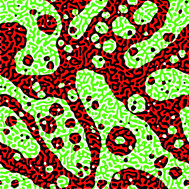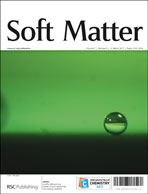Pinning of domains for fluid–fluid phase separation in lipid bilayers with asymmetric dynamics
Abstract
We propose a physical mechanism for the arrest of domain coarsening in a system of two apposed two-dimensional binary fluids. The two fluids are subject to a dynamic asymmetry: strong friction with the environment allows domains in one fluid layer (the “bottom” fluid) to grow only diffusively, whereas hydrodynamic flow leads to initially faster growth in the apposed fluid (the “top” layer). The two fluids are energetically coupled so that domains of similar type interact favorably across the two fluids. Using lattice Boltzmann simulations we observe that at a certain length scale, which is independent of the coarsening state in the bottom layer, domain growth in the top layer comes to an arrest. A phenomenological model suggests the pinning of domains across the two fluids to cause the arrest in domain growth. The pinning results from the interplay between line tension and domain coupling strength across the two fluids. We apply our model to a


 Please wait while we load your content...
Please wait while we load your content...